|
Uncle Orson Reviews Everything
September 8, 2011
First appeared in print in The Rhinoceros Times, Greensboro, NC.
The Very Best Bird Feeders
When I first started feeding birds, I had no idea what I was getting myself in for. There are so
many different birds to feed, with their own appetites and preferences, and so many hazards to
try to avoid, that you can get completely lost in the vast number of choices. And the nearly-as-vast number of possible mistakes.
There are ground feeders (doves and sparrows), perch feeders (finches), and upside-down cling
feeders (woodpeckers). There are seed eaters, worm eaters, fruit eaters, nut eaters, suet eaters,
and eaters of other birds (you try to keep your bird-feeding stations from serving their purposes).
Hazards include squirrels and chipmunks, who can empty or destroy many kinds of feeders
without the birds getting a chance to eat, and rain, which can ruin a feederful of seed, turning it
into a gloppy moldy mess.
Plus, there are big birds that shove the little ones out of the way -- when the crows come, the
sparrows leave.
After several years of this, I can make some firm recommendations about which feeder
arrangements work best, at least in my yard and for my purposes.
First, we have located our feeders on poles with effective squirrel baffles, and now that Edison
the Genius Squirrel is dead, we have no problem with squirrels.
Squirrel baffles on isolated poles work. But "squirrel-proof" feeders do not. You can see cool
videos of squirrels falling off the cleverly designed feeders. What they don't show you is the
squirrels figuring out how to get around the barriers -- which they always do.
If they can get to the feeder at all, they will get food from it -- or shake the feeder so it spills to
the ground where they can get it later.
Second, we have solved the rain problem by installing our feeders -- even the supposedly
waterproof ones -- under waterproof baffles and sunguards, like this one from Duncraft.com:
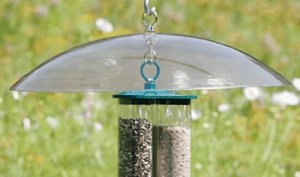
Since we began
protecting our birdfeeders this way, even heavy, windy rainstorms don't spoil the seed.
Using pictures from our two feeding stations, one in the front yard and one on our brick patio,
I'll tell you about the virtues of each of the winning entries.
The losing entries have been sold or given away or left at the curb for scavengers, depending on
just how useless they were.
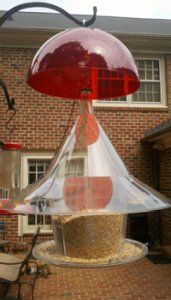
This is the Sky Café A La Carte from
Duncraft.com. Divided into four compartments, it lets you offer four varieties of seed in a self-replenishing way. As birds eat from the tray at the bottom, more spills out from the chamber.
This feeder will show you which seed mixes the birds like and which they disdain -- the popular
ones empty out far faster.
Notice that the sun guard I've placed over it doesn't keep rain off the whole thing. That's
because this feeder is nearly waterproof all by itself. But rain does flow down the chain into the
feeder, unless you keep the rain off the very peak of its roof. And the red umbrella over the top
does that job perfectly.
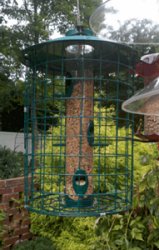
This is the Duncraft Metal Selective feeder. We use
this to keep larger birds from raiding seed mixes designed for small birds like finches. This is
where the thistle and finely chopped sunflower seeds go.
This feeder stays mostly dry. A little rain can be blown in through the apertures, but by and
large rain just hasn't been a problem here.
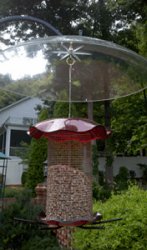
This is the Sunflower Forever Feeder from Doctors
Foster and Smith (www.drsfostersmith.com) . This one only works with whole or nearly whole
shelled sunflower seeds -- but since that is the seed-eaters' overwhelming favorite, the huge
tube means you only have to refill it every couple of weeks.
Birds cling to the mesh surface and pull out seeds, or stop on the perches, or just stand in the
little tray at the bottom. There is a lot of spillage, so this one also supplies the ground feeders
underneath. We put this on the patio so the fallen seeds are on brick -- the chipmunks and
squirrels help the doves and sparrows to keep the patio clean.
But you have to have the rain guard over it, because rain gets into this feeder easily, and it's
miserable to have to throw away that much seed because it's become gluey and moldy after a
wetting.
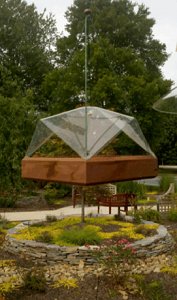
I can't find this hanging platform feeder on any of
my favorite bird-supply websites now, which is a shame, because, while there are many other
covered platform feeders, the roofline on this one, which comes down to the corners, is the best
at keeping the contents dry.
This is the kind of feeder where you lay out selections that include berries and nuts and fruit bits
as well as seeds. A lot of birds that won't come to a seed-only feeder will happy graze here
again and again. But that roof keeps out the crows and other big-bird foodhogs.
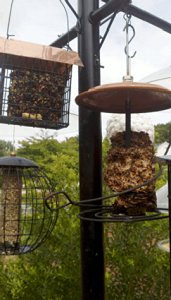
Suet feeders are for the woodpeckers and many
other birds that don't want to waste time on itty-bitty seeds. We have woodpeckers here every
morning, along with a lot of other birds that don't touch anything but the suet.
As you can see, suet gets ugly in the summer heat -- but the birds don't care about pretty. All
suet feeders work about as well as these, but I like the roofs. I don't think the birds care -- suet
doesn't dissolve in the rain.
Wild Birds Unlimited sells the only suet blocks and cylinders that the birds actually like.
I'm not kidding. I've bought suet from other stores and online sites and they just sit there
untouched until they are nauseating to look at. But the suet from Wild Birds Unlimited gets
chomped to bits because the birds want it like beak candy.
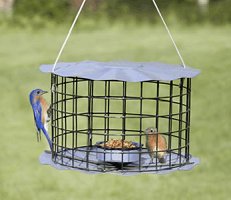
I have to show you the Duncraft.com
version of this Baffled Bluebird Feeder because the picture I took in my yard was too confusing.
The cage keeps larger birds out -- which you must do because crows love mealworms and the
bluebirds never get a chance.
I get my dried mealworms from Wild Bird Unlimited; I've never noticed the birds complaining
because the worms are already dead.
The lid comes up easily. You reach in and lift out the little blue-glass bowl, pour in the
mealworms, and then set it back in place. I'm squeamish, so I appreciate the fact that no
mealworm ever touches my skin.
The mealworms are always gone within two days. And the roof works to keep the bowl in the
middle dry.
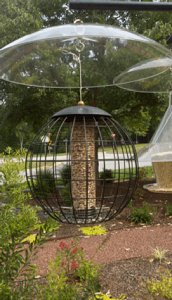
This Squirrel Proof Peanut Globe is far and away
the favorite feeder in our front yard. It was never squirrel proof, of course -- they clung to it and
shook down all the stuff they wanted to -- but the cage keeps out the big birds, so the finches
can really go to town.
I don't put peanuts in it, because our birds mostly ignore them. Instead, I put in large shelled
sunflowers. There's a good bit of spillage, but the ground feeders clean that up. Anything
smaller just flows right out through the mesh, but Duncraft.com also sells a Squirrel Proof Seed
Globe which is the same design, except that the tube is solid, with four ports for perching
feeders.
I just like to see six or eight or ten finches at a time clinging to this one and feasting away.
The squirrel-proof lid, however, is often tricky to put back on. It has to be firmly seated, since it
bears the whole weight of the feeder. It helps if you look closely at the underside of the heavy
black lid and understand how it fits on the tube and the cage before you set it on, press it into its
slots, and then twist it to lock it into place.
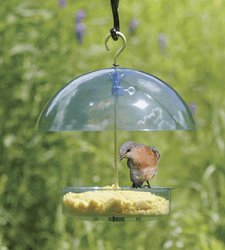
This Droll Yankees Mealworm
Feeder from Duncraft is waiting
for winter. When the hummingbird feeder on the patio gets retired (hummingbird migrate south
for the winter) I'll put this in its place. I won't put mealworms in it, though -- instead I'll put in
suet-and-grain mixtures for the birds that need serious energy to get through the cold season.
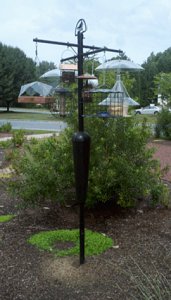
Here's the freestanding feeder station in our front
yard. It's too close to the bush just behind it -- the bush was a lot smaller when we put the pole
here, and by next year the branches will be strong enough for squirrels to climb and jump. But
it's not that hard to screw the pole out of the ground and move it a few feet over.
When I'm not standing there taking a picture, there are birds coming and going at all hours of the
day. The woodpeckers show up mostly in the morning and evening, but finches will eat any
time, and it's fun to see chickadees and bluebirds dining above while doves and sparrows,
chipmunks and squirrels scavenge what has fallen to the ground.
I have tried dozens of other feeders. The failures ranged from feeders so complicated the birds
couldn't figure them out to feeders that I couldn't take apart to clean (all of the ones I've shown
here are easy to wash).
Then there were the elaborate squirrel-proof feeders that turned out to be tests for joining
Squirrel Mensa -- we ended up improving the intelligence of the squirrels in our yard, but the
birds didn't get any more food and it just wasn't worth paying extra for ineffective squirrel
management.
As it is, some of the feeders I use are called "squirrel-proof," but they aren't. It's that black
wobbly tube of a baffle in the middle of the pole that keeps the squirrels out of the feeders. (The
acrylic "baffles" above two of the feeders are there only to keep the rain off -- once they get to
the top of the pole, squirrels get around the hanging baffles easily on a multiple-feeder station
like this.)
And there you have it: Everything I've learned about bird feeders, with pictures.
|